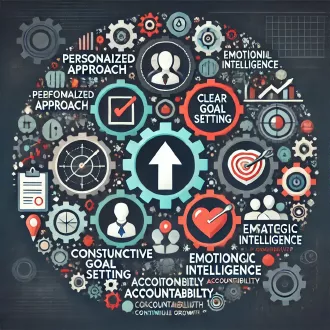Transcription What to avoid in your coaching meetings
If you are looking to apply coaching to your leadership style and intend to guide your employees, you are on the right track to provide them with significant personal and professional growth. In addition, your team will experience improvements in their performance, and your leadership skills will be strengthened. However, in the process of learning how to be a coach, it is common for managers to make some misconceptions about what effective coaching actually entails.
In this regard, here are some of the most common mistakes managers often make when learning to be effective coaches, and how to address these mistakes:
- Telling what to do: one of the most common mistakes is believing that coaching involves providing answers and solutions to others. However, coaching is more about guiding individuals to find their own solutions and take ownership of their decisions. Rather than imposing your own preconceived ideas, you should ask questions that help the other person think and find their own answers.
- Treat coaching as an isolated activity: A common mistake is to consider coaching as an isolated activity instead of integrating it into the daily routine. Coaching should be intertwined with daily work and not limited to occasional meetings. Integrating coaching into daily activities allows you to provide real-time feedback and maximize its impact.
- Overwhelm the coachee: Some leaders tend to put off coaching until they accumulate a long list of concerns. However, by addressing a long list of issues, employees can feel overwhelmed and defensive. Instead of overloading your employees with too many issues, focus on addressing one or two issues at a time for a more effective, quality approach.
- Dominate the conversation: It is common for some managers to dominate the conversation during a coaching session. However, coaching is based on two-way communication and mutual understanding. It is important to listen actively and limit your speaking time to give the other person space to express his or her thoughts and feelings. Avoid constantly interrupting team members while they are talking. Allow them to express themselves fully before responding.
- Speak vaguely: avoid using vague and ambiguous language when providing feedback, even if it is a difficult conversation. Instead of using generic terms such as "you need to practice active listening," be specific and provide concrete examples of observed behaviors. This will allow the person to clearly understand what areas need improvement and how they can achieve it.
- Attacking rather than addressing: Aggression and anger can hinder coaching conversations. When a person feels attacked, they are more likely to defend or shut down rather than constructively address the problem. Approach problems from an objective perspective, look for the root of the problem and collaborate to find solutions. Be aware of your own responsibility in the situation, remain calm and professional, and don't get carried away by emotions. Do not enter a coaching meeting without clarity about the objectives and issues to be addressed. This can lead to unfocused discussions.
- Confusing roles: It is critical to differentiate between your role as a leader or boss and your role as a coach. Make sure you are transparent about what you are doing in each situation and focus your conversations on developing the person rather than imposing your own decisions.
- Prioritize coaching in times of urgency: Don't relegate coaching to the back burner when work becomes urgent. Instead of viewing coaching as a distraction, integrate it in times of crisis to take advantage of development opportunities even in complicated situations.
- Treat coaching meetings like any other meeting: Recognize that coaching is different from traditional follow-up and planning meetings. Be concerned not only with action items but also with how they are doing and whether they need help. Establish a specific focus for coaching conversations and follow a structured model to guide the conversation and get the best long-term results.
- Excessive focus on problems: While it is important to address problems and challenges, don't allow the meeting to focus solely on the negatives. Spend time recognizing the coachee's or team's accomplishments and strengths.
- Impose drastic changes: Don't impose drastic changes without considering the circumstances and the readiness of the team. Work collaboratively to implement changes gradually.
meetings




